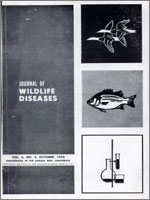Tropical canine pancytopenia (TCP) is a newly recognized infectious disease of dogs in diverse tropical and subtropical areas. The disease is characterized by hemorrhage, pancytopenia, severe emaciation and persistent infection. Dogs with TCP are often presented with epistaxis, which is the most dramatic sign of the disease; however, a large number of fnected dogs develop severe pancytopenia and die without manifesting clinical signs of hemorrhage. The disease has been reported most frequently in the German Shepherd. Pathological findings consist of petechial and ecchymotic hemorrhages on serosal and mucosal surfaces of numerous organs. The most prominent histological finding is a perivascular plasma cell infiltrate in most organs. Disease, indistinguishable from the natural disease, has been produced in laboratory dogs inoculated with whole blood from fnected dogs. Ehrlichia canis has been consistently recovered from all experimentally infected dogs. Attempts to transmit the disease to other laboratory animals and to propagate the agent in cell cultures and embryonating eggs have been unsuccessful. The tick is the probable vector of the disease.
How to translate text using browser tools
1 October 1970
Epizootiology of Tropical Canine Pancytopenia
DAVID L. HUXSOLL,
PAUL K. HILDEBRANDT,
ROBERT M. NIMS,
HERBERT L. AMYX,
JAMES A. FERGUSON





